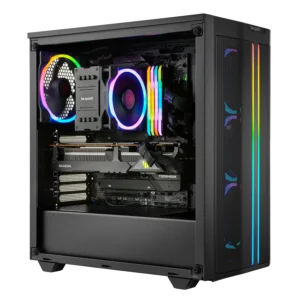Introduction
When diving into the world of sim racing, one of the most critical aspects to consider is the force feedback (FFB) of your racing wheel. Force feedback, measured in Newton meters (Nm), plays a significant role in creating a realistic racing experience by simulating the forces you would feel in a real car. But how much force feedback do you actually need? In this post, we’ll explore different force feedback levels and help you determine the best fit for your sim racing setup.

Understanding Force Feedback in Sim Racing
Force feedback in sim racing wheels is designed to mimic the physical sensations of driving, such as the resistance and vibrations you feel when turning, accelerating, or braking. This feedback enhances immersion and can improve your driving skills by providing tactile cues about the car’s behavior.
Different Levels of Force Feedback
- Entry-Level (2-5 Nm)
- Entry-level racing wheels typically offer 2 to 5 Nm of force feedback. These are often gear or belt-driven systems.
- Suitable For: Casual sim racers and beginners, playing on a desk setup.
- Example Products: Logitech G29, Thrustmaster T300.
- Pros: Affordable, easy to set up, sufficient for basic racing games.
- Cons: Limited feedback strength, less realistic.
- Mid-Range (5-10 Nm)
- Mid-range wheels provide 5 to 10 Nm of force feedback, using Direct Drive systems.
- Suitable For: Intermediate sim racers looking for a more immersive experience.
- Example Products: Moza R5, Moza R9, Simagic Alpha Mini.
- Pros: Better force feedback, more immersive, good balance of performance and cost.
- Cons: Higher cost, may require sturdier mounting solutions.
- Sweet Spot (10-17 Nm)
- Higher-end sim racing wheelbases deliver 10-17 Nm of force feedback. This amount of Nm is generally considered the sweet spot for sim racing. For drifting, you will really never use above 12 Nm. Track racing may require a bit more, but around 15 Nm should be enough for most people as their „lifetime” wheelbase.
- Suitable For: Advanced sim racers seeking the most realistic experience.
- Example Products: Simagic Alpha, Moza R12, Simucube 2 Sport.
- Pros: Exceptional realism, powerful feedback, high precision.
- Cons: Expensive, requires a solid rig, like an aluminium profile one and potentially more technical setup.
- Luxury (17-30+ Nm)
- High-end sim racing wheelbases are like luxury. Most of the people would never need and use that much Nm. Don’t forget that you can set your wheelbases Nm output.
- Suitable For: Professional sim racers or professional racing teams.
- Example Products: Simagic Ultimate, Simucube 2 Ultimate.
- Pros: Powerful feedback and good to flex with.
- Cons: Can be VERY expensive.
Direct Drive vs. Belt-Driven Wheels
- Direct Drive:
- Description: Direct drive wheels connect the wheel directly to the motor, providing the highest level of force feedback and precision.
- Pros: Superior feedback, high durability, minimal mechanical wear.
- Cons: Higher cost.
- Example Products: Moza R5, Simagic Alpha Mini.
- Belt-Driven:
- Description: Belt-driven wheels use belts to transfer force from the motor to the wheel, offering a smoother experience than gear-driven systems.
- Pros: Mid-range cost.
- Cons: Less precise than direct drive, potential belt wear.
- Example Products: Thrustmaster T300, Logitech G29.

How Much Nm For Drifting and Track Racing?
For drifting or rallying, quick and precise counter-steering movements are essential. A moderate force feedback level, typically in the range of 5-10 Nm, is beneficial for this style of racing. Wheels like the Simagic Alpha Mini and Moza R9 are ideal as they provide enough feedback to feel the car’s rear end slipping while maintaining control. It’s important to note that too high a force feedback can make it difficult to counter-steer quickly.
On the other hand, track racing demands a higher level of precision and stability at high speeds. This type of racing benefits from stronger force feedback, usually in the range of 10-17 Nm. High-end wheels with detailed force feedback such as the Moza R16, Simagic Alpha are well-suited for track racing. High force feedback helps in feeling the car’s grip levels and road textures, which improves lap times, consistency and most importantly, immersion.
Choosing the Right Force Feedback for Your Sim Racing Setup
- Assess Your Needs: Determine how seriously you take sim racing. Are you a casual gamer, a dedicated enthusiast, or an aspiring professional who needs maximum realism?
- Budget Considerations: Higher Nm ratings and direct drive systems come at a premium. Balance your desired performance with your budget.
- Mounting and Space: Ensure you have the appropriate setup to accommodate higher force feedback wheels, which often require sturdy mounting solutions and ample space. Aluminium profile rigs are considered best for this, but they require more space and are harder to move.
Conclusion
Selecting the right amount of force feedback is crucial for an optimal sim racing experience. Generally, 10-15 Nm of force feedback will be enough for 95% of sim racers. More than that is for professionals.
Whether you’re just starting with an entry-level wheel or upgrading to a high-end direct drive system from brands like Moza or Simagic, understanding your needs and preferences will help you make the best choice. Remember, the goal is to enhance your immersion and enjoyment in the world of sim racing.
By focusing on the right force feedback, you can transform your sim racing setup into a realistic and thrilling driving experience. Happy racing!





